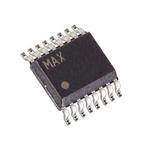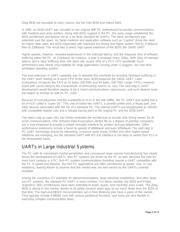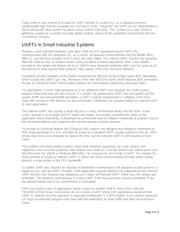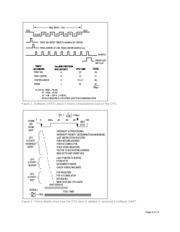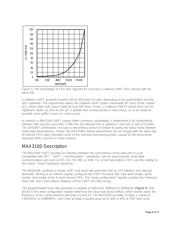herunterladen

Maxim > Design Support > Technical Documents > Application Notes > Interface Circuits > APP 691
Maxim > Design Support > Technical Documents > Application Notes > UARTs > APP 691
Keywords: UART, SPI, QSPI, MAX3100, IrDA, FIFO, universal asynchronous receiver transmitter
APPLICATION NOTE 691
New IC Caps Two Decades of UART Development
Mar 15, 2000
Abstract: Maxim has introduced a tiny universal asynchronous receiver/transmitter (UART) that is
compatible with the miniature electronic components in today's portable products. Compared with well-
established UARTs already on the market, the new MAX3100 offers numerous advantages: lower cost,
higher speed (to 230kbaud), lower power and lower voltage operation (<3V), and special features that
include IrDA timing for IR communications and a FIFO buffer to relieve the processing burden in small
systems. To help minimize size and pin count, the MAX3100 features a synchronous serial peripheral
interface (SPI) for communications.
The reason that such an extensive inventory of UARTs still fails to meet every modern requirement lies in
the incremental nature of UART development. In this article, we review the UART in terms of its major
technical developments, market evolution, and current trends.
Maxim has introduced a tiny universal asynchronous receiver/transmitter (UART) that is compatible with
the miniature electronic components in today's portable products. Compared with well-established UARTs
already on the market, the new MAX3100 offers numerous advantages: lower cost, higher speed (to
230kbaud), lower power and lower voltage operation (<3V), and special features that include IrDA timing
for IR communications and a FIFO buffer to relieve the processing burden in small systems.
Although more than 40 UART devices are available today, they either fail to satisfy some requirements of
today's applications, or they satisfy requirements only through unwelcome trade-offs in size, power, or
speed.
Maxim has identified a need—and a market opportunity—for a newly designed UART that directly meets
today's speed and power requirements and offers the latest special features, without unwieldy
workarounds. Our efforts have resulted in a new UART, the MAX3100.
The reason that such an extensive inventory of UARTs still fails to meet every modern requirement lies in
the incremental nature of UART development. In this article, we review the UART in terms of its major
technical developments, market evolution, and current trends.
UARTs in PC Applications Systems
One of the first large-scale-integration (LSI) chips ever developed (predating the single-chip
microprocessor by several years), the UART has been available since the early 1970s. Constantly
refined rather than reinvented, it has shown little change over the years in its pin names, function names,
or general mode of operation. Modern CMOS UARTs like the National Semiconductor 16550 and the
Page 1 of 13

